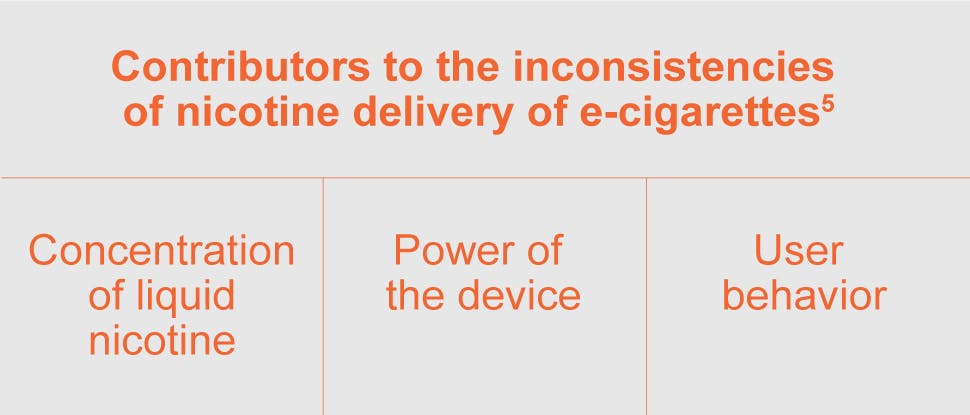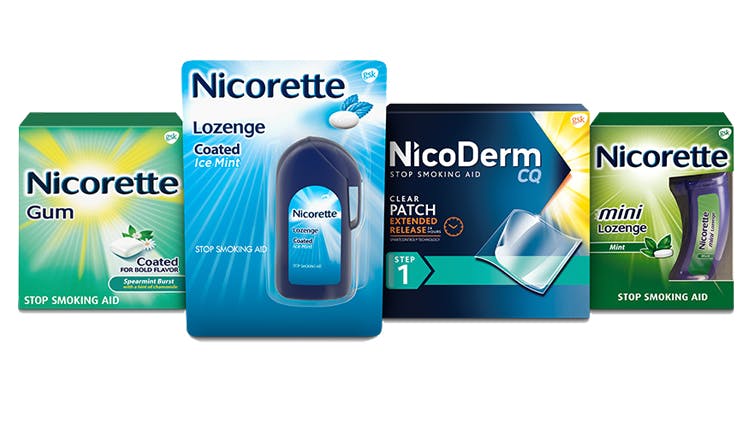E-Cigarettes/Vaporizers (VAPES)

E-cigarettes are unproven and non-therapeutic
A World Health Organization study group concluded that there was insufficient evidence surrounding the use of e-cigarettes as smoking-cessation aids.1 "They, therefore, recommend that smokers use a combination of approved conventional smoking cessation treatments to quit smoking." E-cigarettes are not properly regulated; For example, patients may try combining the effects of a 24-hour therapy for steady support throughout the day with a product that provides additional craving relief as needed.
The US Food and Drug Administration issued a press release discouraging the use of e-cigarettes and stated concerns that these products may be marketed to young people, and lack appropriate health warnings2
E-cigarettes may still lead to addiction and health risks
Some people believe e-cigarettes may help lower nicotine cravings, but there is no conclusive evidence to support their effectiveness in long-term smoking cessation.3
E-cigarettes contain chemicals, including toxicants and potential carcinogens. Research suggests that e-cigarettes may be less harmful than cigarettes, but they can still lead to nicotine addiction and other health issues.3
Aerosols produced by e-cigarettes and inhaled by users contain many compounds, including4:
- Nicotine
- Nicotyrine
- Formaldehyde
- Acetaldehyde
- Glycidol
- Acrolein
- Acetol
- Diacetyl
Additional carcinogens and toxic heavy metals have been detected, highlighting the need for investigations into the potential health consequences.5
In heavy users (250 puffs/day), formaldehyde, acrolein, and diacetyl may be inhaled at levels that exceed US occupational limits.6
DID YOU KNOW?
Diacetyl was heavily used in microwave popcorn flavoring. In the early 2000s, inhalation of diacetyl was found to be associated with bronchiolitis obliterans, also known as ‘popcorn lung’, when several popcorn-processing plant workers developed the condition.7
E-cigarette user trends
According to the Surgeon General’s Report in 2016, e-cigarette use among youth and young adults has become a public health concern. In 2014, e-cigarettes became the most commonly used tobacco product among youth, and use of e-cigarettes by young adults (ages 18–24) surpassed that of adults (≥25 years).5
In 2015, an estimated 27.1% of adolescents in the US reported having tried e-cigarettes.5

E-cigarette use in students
Frequency of e-cigarette use increased with conventional cigarette smoking.5

Reasons for e-cigarette use
An analysis of over 3 million tweets from 2012 to 2015 suggests a shift in the reasons for using e-cigarettes from smoking cessation toward establishing a social image. 8
Additional reasons include5:
- Curiosity
- Flavorings
- Less harmful/toxic alternative to conventional cigarettes
- Avoidance of indoor smoking restrictions

Inconsistency in nicotine doses
The concentrations of nicotine found within e-cigarettes vary between devices, and they vary more widely than those found in conventional cigarettes.5
E-cigarettes are not properly regulated: they currently deliver higher, lower, or similar amounts of nicotine compared with conventional cigarettes.5,9
Device differences:
A study of 16 e-cigarettes in laboratory settings showed total vapor nicotine levels ranging from 0.5 to 15.4 mg after 20 series of 15 puffs.10
Between-subject differences:
Using the same device and liquid dose, plasma concentrations of nicotine between subjects varied from 0.8 to 8.5 ng/mL at 5 minutes.5,11
Read more about smoking cessation




Non-prescription management options
Learn more about non-prescription management options for quitting smoking.

NicoDerm CQ Patch and Nicorette Products
Find out how the NicoDerm CQ Patch and Nicorette products can help your patients.
